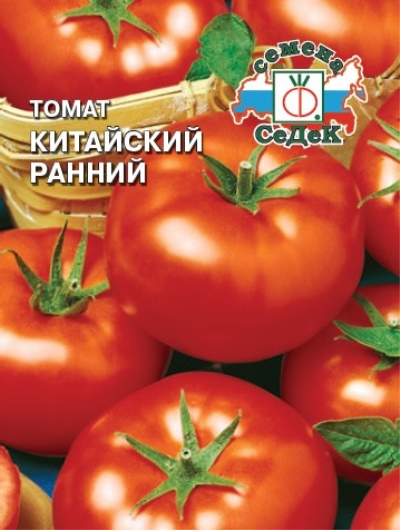
- Category: grade
- Growth type: determinant
- Appointment: universal
- Ripening period: early
- Ripening time, days: 95-100
- Growing conditions: for open ground, for film greenhouses
- Bush size: low
- Bush height, cm: 45-55
- Ripe fruit color: Red
- Fruit shape: flat-round
In order to feast on fresh tomatoes as early as possible, you need to opt for early varieties. For some Russian summer residents, this characteristic is decisive when laying a vegetable plantation. Also, the selected vegetable crop should delight with a regular harvest and a wonderful taste. These are the features of the early Chinese tomato.
Description of the variety
Small plants grow to only 45-55 centimeters in height. Growth type is determinant. Tomatoes can be grown in any conditions, be it film greenhouses (greenhouses) or open-air beds. Fruits, universal in use, are suitable for fresh consumption or preparation of various dishes and preparations.
The bushes of this variety can be identified by their compact size and shape, which makes them convenient to cultivate even in small areas. Low growth allows you to comfortably grow tomatoes in temporary greenhouses. Leafiness is moderate. On one cluster, from 5 to 6 tomatoes of the same size are formed.
The main qualities of the fruit
Green vegetables turn into a deep red color as they ripen. Average weight ranges from 70 to 110 grams, but with proper care and under favorable conditions, they can grow up to 150-200 grams. Tomatoes are rounded and slightly flattened. They are often grown for sale due to their resistance to cracking. The pulp is very juicy and moderately dense. The skin is smooth with a glossy sheen. There are few seed nests.
Ripe vegetables are easily transported without losing their appearance and other qualities. Due to their juiciness and small amount of seeds, juices and sauces are often made from them.
Taste characteristics
The ripe fruit tastes excellent. The harvest is stored for a long time. To preserve the crop for as long as possible, it must be stored in convenient containers and in a cool room.
Ripening and fruiting
The Chinese Early variety fully justifies itself by its ripening period, which is 95-100 days. Harvested between July and September.
Yield
A yielding crop forms up to 12 kilograms of vegetables per square meter of the plantation.
The timing of planting seedlings and planting in the ground
In the first spring month, seeds are sown for seedlings. As soon as the seedlings are 60-65 days old, they are transplanted to a permanent planting site. Work can be carried out only after the soil has warmed up sufficiently. Also, the timing depends on the climatic conditions. On the territory of temperate latitudes, sowing is carried out in the period from 1 to 2 ten days of March. In the northern or southern regions, the date is shifted by about 1-2 weeks.
Features of growing seedlings of the Chinese early variety.
- As fertilizers use ready-made complex formulations, for example, "Fertika", "Chamfer" or "Biomaster".
- Water the plants as the soil dries up. For irrigation, use a spray bottle or syringe.
- Seedlings need to be turned towards the sun's rays, and on a short daylight hours, the tomatoes are illuminated with phytolamps.
- After the appearance of two leaves, a pick is carried out in separate containers.
- Hardening is carried out about two weeks before transplanting plants into open ground or a greenhouse.Without this procedure, tomatoes may not take root in a new place.

Growing tomato seedlings is an extremely important process, because it largely depends on whether the gardener will be able to harvest at all. All aspects must be taken into account, from seedbed preparation to planting in the ground.
Landing scheme
The recommended planting scheme for bushes is 50x40 centimeters.

Growing and care
To achieve maximum yields, you need to grow Chinese early tomato in well-lit areas. Also, the culture prefers fertile land. Planting holes are prepared in advance. It is advisable to clean the site of debris and level it if necessary. A tablespoon of ash is placed in each pit. This component will feed the bushes after transplanting.
Next, pinching is carried out. Removing unnecessary lateral shoots will preserve the strength of the plant, which will be used for the formation of fruits. Due to their small stature, it is not necessary to tie up the bushes, but some gardeners install supports or posts. The supports will hold the branches, which begin to tilt towards the ground under the weight of the fruit. Fruit contact with the ground is highly undesirable. Also, do not forget about other agricultural activities: watering, loosening, disease prevention, fertilization and other manipulations.
The above variety does not have any special requirements for the irrigation system. The vegetable plantation is irrigated in the same way as when growing ordinary tomatoes. Moisten the earth as needed. Both liquid stagnation and drying out must not be allowed. In the first case, a fungus may develop, and in the second, the fruits will become small and dry.
For a week, no more than three liters of settled and warm water is used per plant. With the formation of the crop and its ripening, the bushes begin to irrigate more often. Also, the frequency of watering is increased in the dry season.
Experienced gardeners recommend forming the bushes into two trunks. It is advisable to grow a crop in open ground only in the south of the country with a temperate and warm climate. Early varieties of tomatoes do not tolerate low night temperatures.




A plant needs different micronutrients at each stage of growth. All fertilizers can be divided into two groups: mineral and organic. Folk remedies are often used: iodine, yeast, bird droppings, eggshells.
It is important to observe the rate and period of feeding. This also applies to folk remedies and organic fertilizers.



























































































